|
DAY OF
THE DEAD:
GIGANTIC KITE FESTIVAL
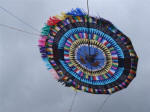 November
1 is All Saints Day, known here as the Day of the Dead (following Halloween
- "All Hallow's Eve"). It is the day to celebrate the lives of
deceased loved ones. Communities celebrate in a variety of ways, from
costumed dancing to horse races. In Guatemala there are 2 towns near
Antigua,
Santiago Sacatepéquez and
Sumpango, that celebrate this event with the feria de los barriletes
gigantes, or gigantic kite festival. November
1 is All Saints Day, known here as the Day of the Dead (following Halloween
- "All Hallow's Eve"). It is the day to celebrate the lives of
deceased loved ones. Communities celebrate in a variety of ways, from
costumed dancing to horse races. In Guatemala there are 2 towns near
Antigua,
Santiago Sacatepéquez and
Sumpango, that celebrate this event with the feria de los barriletes
gigantes, or gigantic kite festival.
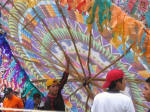 (The
largest are 50 ft. in diameter.) These festivals take place in the
cemetery and at first (and in the end) appear to be a rather irreverent way
to celebrate the deceased's life, trampling over their graves and climbing
on top of mausoleums for a better view of the activities, vendors pushing
food carts over decorated dirt mounds. Flying kites, it is
believed, creates a communication line between the living on earth and the
deceased above for a day. Some say the sound of the wind in the kites
chases away the evil spirits that cause bad harvests, sickness, etc. Deceased are also honored with flowers and
food, and candles are lit at nighttime. We attended the 107th annual
Gigantic Kite Festival in Santiago Sacatepéquez, the larger of the two
festivals. (The
largest are 50 ft. in diameter.) These festivals take place in the
cemetery and at first (and in the end) appear to be a rather irreverent way
to celebrate the deceased's life, trampling over their graves and climbing
on top of mausoleums for a better view of the activities, vendors pushing
food carts over decorated dirt mounds. Flying kites, it is
believed, creates a communication line between the living on earth and the
deceased above for a day. Some say the sound of the wind in the kites
chases away the evil spirits that cause bad harvests, sickness, etc. Deceased are also honored with flowers and
food, and candles are lit at nighttime. We attended the 107th annual
Gigantic Kite Festival in Santiago Sacatepéquez, the larger of the two
festivals.
|
|
LAKE ATITLÁN
(Lago de Atitlán)
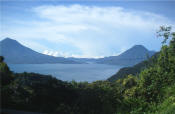 This
gem of a lake - considered by many travelers as one of the most beautiful lakes in the
world - is located in the Western Highlands
of Guatemala. It is surrounded by majestic volcanoes and Maya villages.
With a depth of 1,000 ft., this volcanic crater lake is the deepest lake in
Central America. This
gem of a lake - considered by many travelers as one of the most beautiful lakes in the
world - is located in the Western Highlands
of Guatemala. It is surrounded by majestic volcanoes and Maya villages.
With a depth of 1,000 ft., this volcanic crater lake is the deepest lake in
Central America.
Interestingly, in the late 1950's in an effort to boost
tourism, Pan American Airlines recommended stocking Lake Atitlán with fish
for angler enthusiasts. Non-native black bass were brought in which
took to their new environment too well, eating over two-thirds of the native
inhabitants. This in turn contributed to the extinction of the giant
grebe, a rare bird the only lived around this lake.
The Lake is typically a 3-hour ride from Guatemala City, snaking through the
mountains. The latter part of the trip was very slow going in the dark
with dense ground fog
and lots of traffic - both vehicular and pedestrian. Fortunately, we were using a private shuttle van service that employs
conscientious drivers, getting us there in one piece but needing a drink. We spend our
first night in
Panajachel, the "gateway"
to Lake Atitlán, staging there for
our Sunday morning trip to Chichicastenango.
Chichicastenango
lies north and is a long 1-hour windy drive through the high mountains, quite
scenic as we drive through tiny villages, locals in traditional dress
walking the roadway. Chichi is well-known for it's Sunday (and
Thursday) market days: It's a humongous, colorful street market
encompassing numerous blocks. Locals come from all
 |
 |
 |
 |
 |
|
Sunday on the church steps with
offerings . . . |
. . . of individual
fires and marigolds for the dead. |
Very long aisles between the market
stalls. |
Indoor food market. |
A patchwork quilt made from various
huipiles. |
over the area, carrying their wares on
their backs. Although we did not witness this, we hear watching them
set up their tents/stalls the night before, and then tear them down the next
night, is pretty incredible. For Linda and Deborah who were in the
buying mood for textiles, the experience was overwhelming, pressing forward
through thick crowds of mostly local Mayas. Navigating back to a
specific stall took perseverance but paid off, as Linda and Deborah both
bought antique runners - textiles of this nature we had not seen any place
else except in Antigua at one upscale shop. Lighter on cash . .
. but the girls happy
. . . we take the early shuttle back to Panajachel and
embark to our next destination via the only practical means of getting
around the lake - the water taxi shuttle.
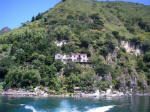 Our next destination was at
La
Casa del Mundo in Jaibalito
on the north side of the lake. It is a
collection of about 15 rooms scattered up and down a secluded cliff, each room overlooking the
lake with a view of the three volcanoes. The Canadian owners have
taken 15 years to artfully build this spectacular place, with stone
walkways, balconies, patios, terraces and beautiful Our next destination was at
La
Casa del Mundo in Jaibalito
on the north side of the lake. It is a
collection of about 15 rooms scattered up and down a secluded cliff, each room overlooking the
lake with a view of the three volcanoes. The Canadian owners have
taken 15 years to artfully build this spectacular place, with stone
walkways, balconies, patios, terraces and beautiful
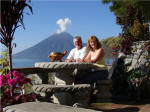 gardens all over the
cliff side. The whole place is tastefully decorated with local
textiles (labeled by pueblo) and other artwork. Lex &
Linda's room
was a serious hike way up to the top; Steve & Deb's room was at restaurant level
where we could keep an eye on the stoking of the hot tub. The
wood-fired hot tub for a dozen (you have to reserve it 24 hours in
advance so they can fill it with fresh water and heat it just for you) juts
out over the lake, volcanoes in view! A swim at sunset in the clean
lake was exhilarating. A delicious 3-course family
style dinner at one long table for all guests was a great way to meet
international travelers, not to mention the hot tub (again) afterwards!
After breakfast the next morning, another dip in the lake for a hair wash -
and picture taking from way out - was in order. This is a DO NOT MISS experience. Our only regret is that we were not
able to spend another night here. gardens all over the
cliff side. The whole place is tastefully decorated with local
textiles (labeled by pueblo) and other artwork. Lex &
Linda's room
was a serious hike way up to the top; Steve & Deb's room was at restaurant level
where we could keep an eye on the stoking of the hot tub. The
wood-fired hot tub for a dozen (you have to reserve it 24 hours in
advance so they can fill it with fresh water and heat it just for you) juts
out over the lake, volcanoes in view! A swim at sunset in the clean
lake was exhilarating. A delicious 3-course family
style dinner at one long table for all guests was a great way to meet
international travelers, not to mention the hot tub (again) afterwards!
After breakfast the next morning, another dip in the lake for a hair wash -
and picture taking from way out - was in order. This is a DO NOT MISS experience. Our only regret is that we were not
able to spend another night here.
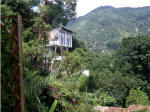 A little further west is
Aaculaax in San Marcos La Laguna.
San Marcos, a tiny laid-back eco-friendly town, is known for its yoga,
massage, holistic and other naturalistic centers. A walk
through the coffee crops with the help of "boat-boy types" puts us at our
next destination. The
German-owned Aaculaax has about 10 rooms A little further west is
Aaculaax in San Marcos La Laguna.
San Marcos, a tiny laid-back eco-friendly town, is known for its yoga,
massage, holistic and other naturalistic centers. A walk
through the coffee crops with the help of "boat-boy types" puts us at our
next destination. The
German-owned Aaculaax has about 10 rooms
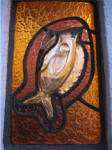 built into the living rock, dotted
along the hillside, each with lake and volcanoes
views and private patios. The entire place is made from recycled and natural materials.
Many walls are made of chicken wire filled with plastic bottles stuffed hard with plastic food wrappers/bags,
then plastered over. This helps recycle non-biodegradable trash and provides great insulation. Other walls are filled with volcanic rocks gathered from the lake shore.
The owner is really into stained glass and tile work so there’s lots of
it all around including embedded into the rooms’ walls, doors and baths.
(The stained glass is all made from recycled glass and bottles; paper maché,
not metal, is used to brace the glass.)
Lex & Linda
had the "honey-moon" suite (The Mirador) which was a pristine 2-story affair
with a fantastic view of the three volcanoes from their bed - and from their
outdoor bathroom and hot
tub! We had The Pescador (The Fisherman) room, a cozy room with
the same great lake/volcanoes view from the bed, shower carved out of the rock
hill, patio on roof top. Really cool place, a bit funky, clean and
uniquely interesting. built into the living rock, dotted
along the hillside, each with lake and volcanoes
views and private patios. The entire place is made from recycled and natural materials.
Many walls are made of chicken wire filled with plastic bottles stuffed hard with plastic food wrappers/bags,
then plastered over. This helps recycle non-biodegradable trash and provides great insulation. Other walls are filled with volcanic rocks gathered from the lake shore.
The owner is really into stained glass and tile work so there’s lots of
it all around including embedded into the rooms’ walls, doors and baths.
(The stained glass is all made from recycled glass and bottles; paper maché,
not metal, is used to brace the glass.)
Lex & Linda
had the "honey-moon" suite (The Mirador) which was a pristine 2-story affair
with a fantastic view of the three volcanoes from their bed - and from their
outdoor bathroom and hot
tub! We had The Pescador (The Fisherman) room, a cozy room with
the same great lake/volcanoes view from the bed, shower carved out of the rock
hill, patio on roof top. Really cool place, a bit funky, clean and
uniquely interesting.

Lake Atitlán has 12 pueblos scattered around the lake - named after the 12
apostles. A morning trip to
Santiago Atitlán (St.
Anthony?) afforded us another great opportunity to see local villagers
wearing their traditional dress - here the men proudly sport their colorful
trajes. We paid our respects to Maximόn (see below). We browsed
the numerous shops
 and
street vendors in search of huipiles, the traditional woman's blouse.
Santiago Atitlán's known for their very elaborately embroidered huipiles
with birds on it. Since we are gringos, the prices start high and you
have to learn to bargain down to 25-50% of the original asking price, which and
street vendors in search of huipiles, the traditional woman's blouse.
Santiago Atitlán's known for their very elaborately embroidered huipiles
with birds on it. Since we are gringos, the prices start high and you
have to learn to bargain down to 25-50% of the original asking price, which
 we
did. The women will follow you through the streets, gradually reducing
their price. As we pulled away from the dock, a last ditch effort by
Steve to secure a huipil resulted in big savings. Still, we
probably should have negotiated harder - that's hard to do when you
understand the amount of time and work that goes into each huipil.
The lady at left has 4 front teeth with various gold-design inlays/borders -
a sign of prestige, the more the better. we
did. The women will follow you through the streets, gradually reducing
their price. As we pulled away from the dock, a last ditch effort by
Steve to secure a huipil resulted in big savings. Still, we
probably should have negotiated harder - that's hard to do when you
understand the amount of time and work that goes into each huipil.
The lady at left has 4 front teeth with various gold-design inlays/borders -
a sign of prestige, the more the better.
|
 Maximόn
(mah-shee-mohn) We paid our respects
(i.e., paid money) to Maximόn, Maximόn
(mah-shee-mohn) We paid our respects
(i.e., paid money) to Maximόn, the cigar-smoking, booze-drinking, silk-draped highland Maya deity.
He is a fusion of traditional Maya saints, Catholic saints and Spanish
conquistador legends. Maximόn embodies all the “good” things in
life – he especially likes offerings of rum, cigars and candles.
He lives with a lucky family (lucky 'cause they get all the goodies) for
a year, then is paraded through the streets during Santa Semana (Holy
Week / Easter) before moving to another lucky family for a year.
Inside the entry way a woman, right, stokes an offering fire while
smoking two cigars - we're sure she did Maximόn proud!
the cigar-smoking, booze-drinking, silk-draped highland Maya deity.
He is a fusion of traditional Maya saints, Catholic saints and Spanish
conquistador legends. Maximόn embodies all the “good” things in
life – he especially likes offerings of rum, cigars and candles.
He lives with a lucky family (lucky 'cause they get all the goodies) for
a year, then is paraded through the streets during Santa Semana (Holy
Week / Easter) before moving to another lucky family for a year.
Inside the entry way a woman, right, stokes an offering fire while
smoking two cigars - we're sure she did Maximόn proud! |
Lake Atitlán is the site of the
horrendous Guatemalan floods and mudslides caused by hurricane Stan in
October 2005. Mile-wide rivers of mud from the saturated volcano
slopes literally buried whole villages under 15-20 ft. of mud, creating
massive gravesites. The most devastation of all was right here in a
little community of Santiago Atitlán; also San Marcos (Aaculaax town).
A couple of thousand Maya lives were lost and several thousand homeless.
Guatemaltecos speak of it frequently and as you saw with the kite festival,
pay homage to it.
Santiago Atitlán is also the place of
the 1981 assassination of a missionary. In 1990, a protest at the army
base resulted in Santiago Atitlán being made "a military free zone".
This area certainly has had it's difficulties, as it's population was also
hit hard during the decades of violent civil war.
- - -
 We
bought some nice textiles here in Santiago Atitlán, Chichi and Antigua,
including several
huipiles. Even with our "tough" negotiations I'm sure we
still overpaid. To see a sample of our textile purchases, see
Guatemalan Textiles Bought. At the bottom of that page is a
really great drawing and explanation of the
Parts of the Backstrap Loom used for Mayan Weaving. We
bought some nice textiles here in Santiago Atitlán, Chichi and Antigua,
including several
huipiles. Even with our "tough" negotiations I'm sure we
still overpaid. To see a sample of our textile purchases, see
Guatemalan Textiles Bought. At the bottom of that page is a
really great drawing and explanation of the
Parts of the Backstrap Loom used for Mayan Weaving.
We have put together
Lake Atitlán Trip
Recommendations
which includes information and prices on recommended lodging and transportation,
logistics and trip tips in general. |
![]()